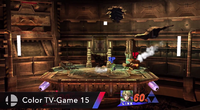Color TV-Game 15: Difference between revisions
No edit summary |
(Ugh.) |
||
| Line 16: | Line 16: | ||
}} | }} | ||
The '''Color TV-Game''' was | The '''Color TV-Game 15''' was one of the consoles of the ''[[wikipedia:Color TV-Game|Color TV-Game]]'' line, acting as one of Nintendo's first forays into the video game industry. Released in 1978, the console currently acts as the oldest entity in the ''[[Super Smash Bros. (series)|Super Smash Bros.]]'' series, being two years older than [[Mr. Game & Watch]]'s debut in 1980. | ||
== | ==In ''[[Super Smash Bros. 4]]''== | ||
===As an [[Assist Trophy]]=== | |||
File:PongWiiU.png|Color TV-Game 15 Assist Trophy as it appears in {{forwiiu}}. | [[File:PongWiiU.png|thumb|left|Color TV-Game 15 Assist Trophy as it appears in {{forwiiu}}.]] | ||
The Color TV-Game 15 made its ''Smash Bros.'' debut as an [[assist trophy]] in the fourth game of the series. Upon being summoned, two paddles from the game appear on-screen, playing a game of Pong by themselves, with the score appearing above each paddle. While it has been confirmed that the ball that is hit between the two paddles can damage players, it is not known if the paddles themselves have any effect on gameplay. | |||
== | ==Origin== | ||
[[File:RealLifeColorTVGame15.png|thumb|right|The ''Color TV-Game 15''.]] | |||
The ''Color TV-Game'' line of consoles was a series of consoles produced by [[Nintendo]] in the late 1970s, with all consoles only being released in Japan. The ''Color TV-Game'' series was among the numerous [[wikipedia:Pong|''Pong'' clones]] produced after the production of ''Pong'' by [[wikipedia:Nolan Bushnell|Nolan Bushnell]] in 1972. The ''Color TV-Game 15'' was the second iteration of the console, featuring fifteen game variants over the seven offered by its predecessor. | |||
{{stub}} | {{stub}} | ||
Revision as of 19:21, April 19, 2014
| Color TV-Game 15 | |
|---|---|
 File:Symbol.png Color TV-Game 15, as it appears in Color TV-Game 15. | |
| Universe | Color TV-Game |
| Debut | Color TV-Game 6 (1977) |
| Smash Bros. appearances | SSB4 |
| Most recent appearance | WarioWare: Smooth Moves (Cameo, 2006) |
| Console of origin | Color TV-Game |
| Article on Wikipedia | Color TV Game |
The Color TV-Game 15 was one of the consoles of the Color TV-Game line, acting as one of Nintendo's first forays into the video game industry. Released in 1978, the console currently acts as the oldest entity in the Super Smash Bros. series, being two years older than Mr. Game & Watch's debut in 1980.
In Super Smash Bros. 4
As an Assist Trophy

The Color TV-Game 15 made its Smash Bros. debut as an assist trophy in the fourth game of the series. Upon being summoned, two paddles from the game appear on-screen, playing a game of Pong by themselves, with the score appearing above each paddle. While it has been confirmed that the ball that is hit between the two paddles can damage players, it is not known if the paddles themselves have any effect on gameplay.
Origin
The Color TV-Game line of consoles was a series of consoles produced by Nintendo in the late 1970s, with all consoles only being released in Japan. The Color TV-Game series was among the numerous Pong clones produced after the production of Pong by Nolan Bushnell in 1972. The Color TV-Game 15 was the second iteration of the console, featuring fifteen game variants over the seven offered by its predecessor.


